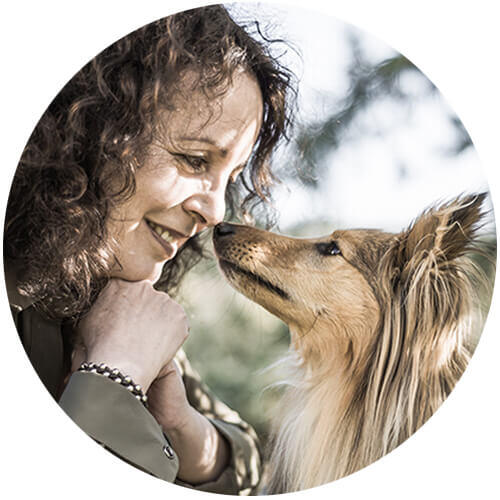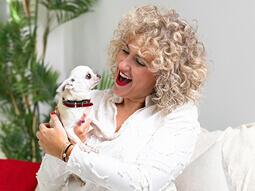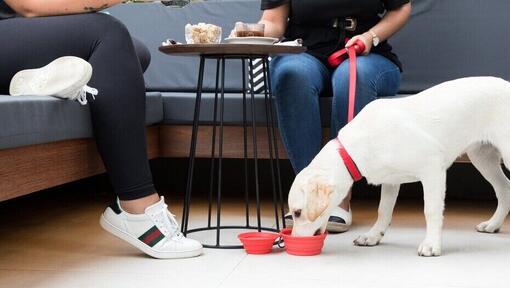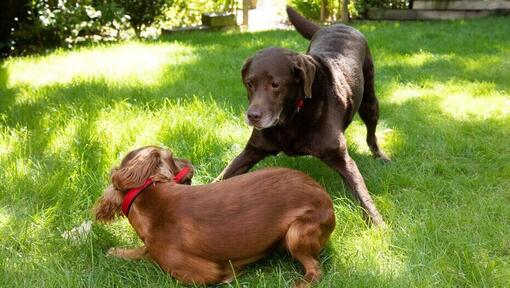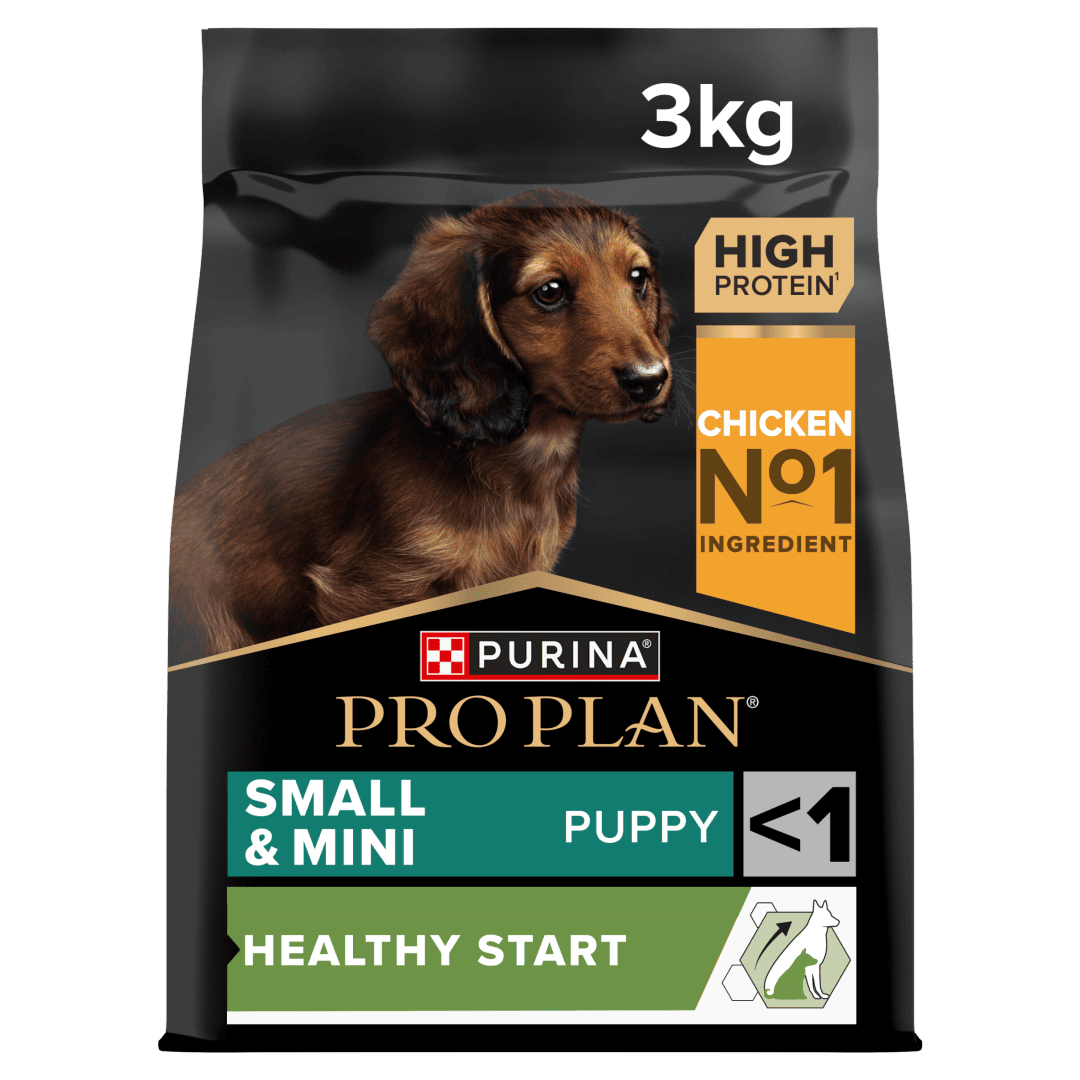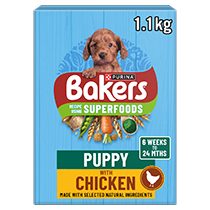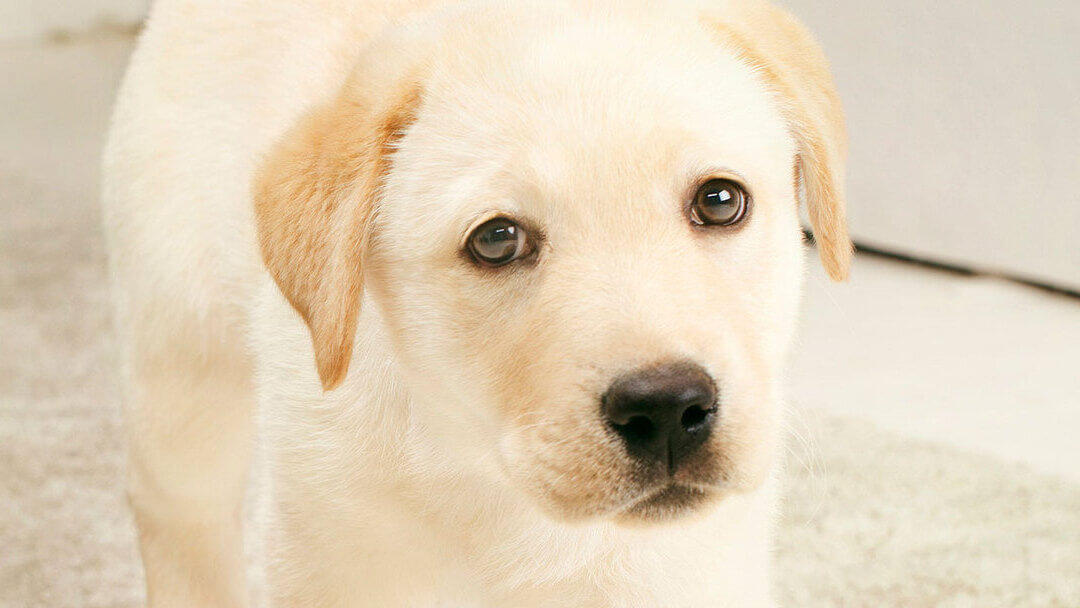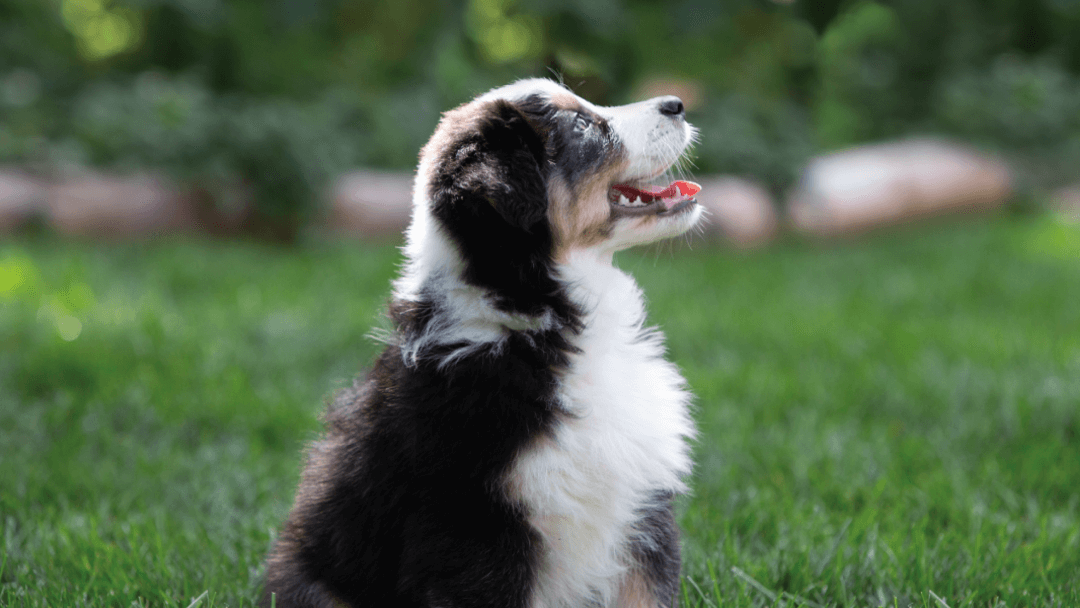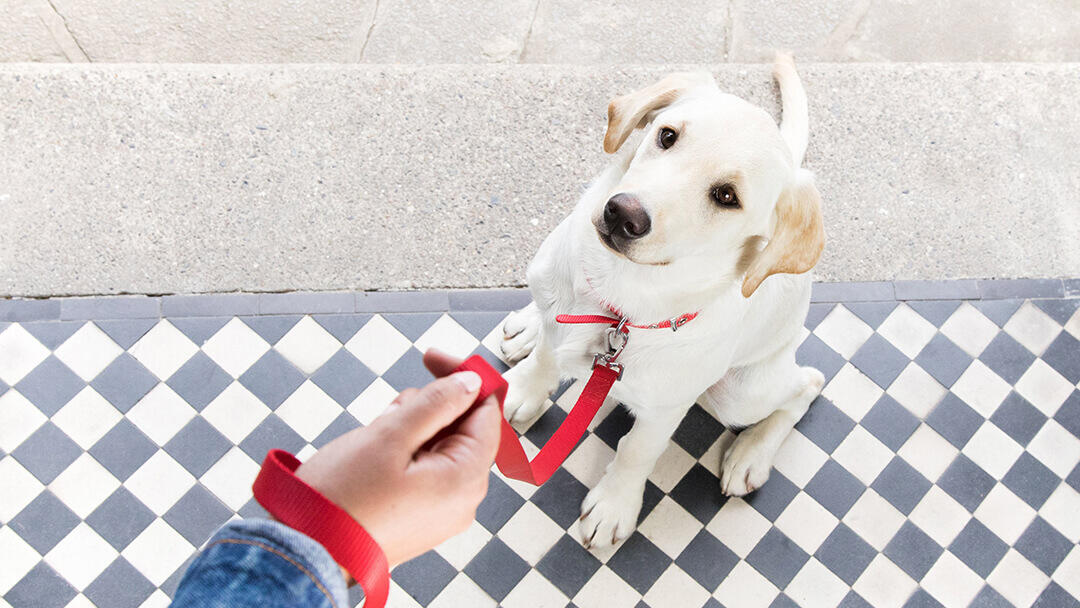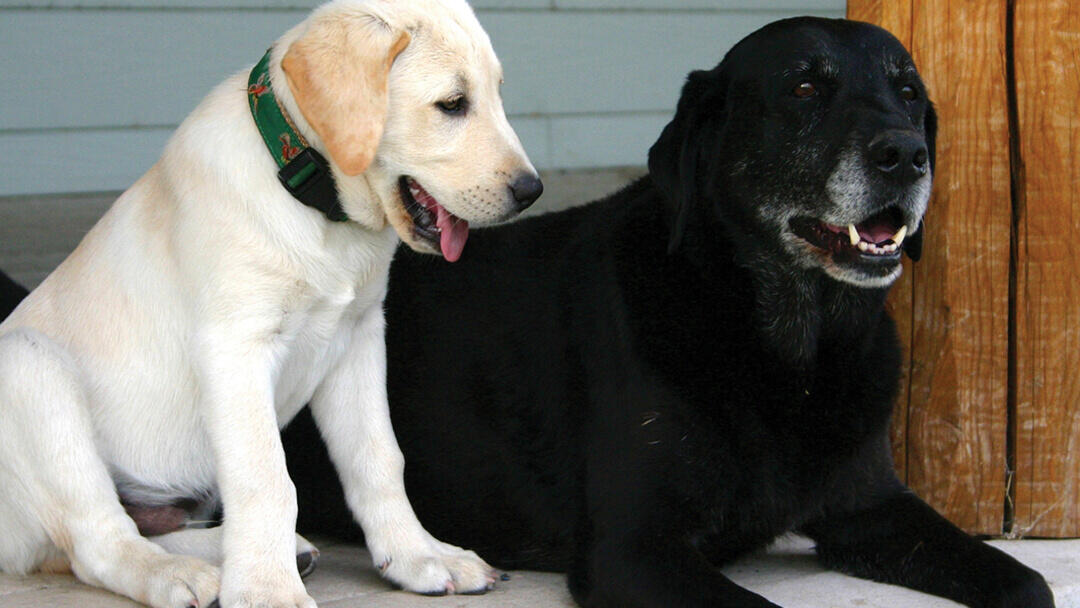

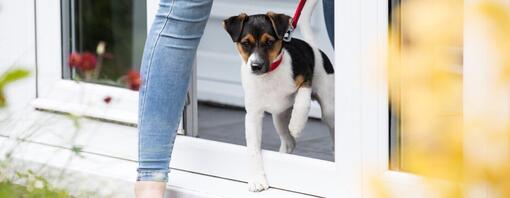
There are certain times during the development of your puppy’s brain when they are totally accepting of new things, and when you can help them become the friendly and outgoing companion you’ve always dreamed of, without the fears and phobias so many dogs go on to develop as they get older. Managing these early encounters and situations well will be important for your dog’s behaviour and your future life together.
That’s why at Purina, we’ve enlisted our in-house behaviourist to give us some essential tips on socialising your puppy during lockdown too.
Puppy socialisation is just one of the many things to think about when you get your puppy and when you start puppy training. You suddenly find you have a huge shopping list, you have to ensure your house and garden are ‘puppy safe’, and of course you will be thinking about how to ensure your new arrival grows up to be a happy, healthy, well-behaved dog. Too often however people forget about helping their puppy learn the most important thing – how to fit into our crazy lives.
This is where puppy socialisation comes in – and while most people know that puppies need to be socialised, few understand what that really means, when to do it and how to do it properly.
What is puppy socialisation?
Puppy socialisation is important because all animals are hardwired to be scared of new things – this is the self-preservation instinct that ensures animals avoid things that could be dangerous. In a newly-born animal however everything is new – so nature gives them a narrow window of development where things they are introduced to, as long as they aren’t scary and don’t hurt, are looked on as just being part of life and nothing to be scared of. After this period, new things will be regarded with fear or suspicion. This is the cause of many behaviour problems.
In our puppies, this period is between 3 week and 14 weeks of age (in some breeds this goes on slightly later and in others, that period closes earlier).
Puppy socialisation teaches puppies how to behave and be happy and relaxed when they encounter humans, other dogs, other animals and the world around them. Puppy socialisation can also help puppies have a better relationship with their owners and become used to being in a range of environments and scenarios. Puppy socialisation is one of the best tools we have to prevent future behaviour problems in dogs, and it’s also how we can ensure we have a dog who we can take everywhere with us and share the bond that we dream of having when we bring our puppy home.
While it all often gets lumped in together, there are two parts to puppy socialisation.
In essence, socialisation means you can play with it, habituation means you can ignore it!
The first bit involves introducing the puppy to all the things you want them to have a social relationship with – hence why it is called ‘socialisation’. This is going to be people (of all kinds and ages) and other dogs.
The other bit is habituation, and this teaches the puppy that while there are lots of things in their new life that might feel potentially scary or wildly distracting, these are just things to ignore and not get worried or excited about. This can be everything from vacuum cleaners to fireworks, joggers to livestock, traffic to cyclists, and so on.
Most behaviour problems come from fear – puppy aggression towards people is generally fear of strange people, aggression to dogs starts from a fear of strange dogs, noise phobias come from fear of strange or loud noises, separation anxiety comes from fear of being alone, and so on.
Puppy socialisation and habituation is all about preventing these fears, lessening the likelihood of behaviour problems, and so creating a well-adjusted, happy, social dog.
In essence, socialisation means you can play with it, habituation means you can ignore it!
When to focus on puppy socialisation and habituation
The tricky bit of puppy socialisation is that there are only certain times during the development of your puppy’s brain when these things can be learnt. All cells in the body have a time to grow and a time to stop growing, and the brain is no different. After that, the window of opportunity in your dog’s development responsible for the soft skills (communication, social interaction, conflict resolution) along with working out what is part of life and therefore ‘safe’, more or less closes.
This means that the way that dog will react to people, other dogs, situations, their social skills and their behavioural competencies are pretty much now set in stone. Additional learning can happen but when it comes to the way the dog reacts to the world around them – their personality – this is formed in these early weeks and anything else will always be ‘playing catch-up’.
The puppy socialisation period begins when your puppy starts to become sentient at around 15 days old and finishes at about 14 weeks old, but this can vary in different breeds and types. During this time, they are learning who their social group is, who they feel safe around, and who they are happy to look on as part of their family.
The habituation part is far shorter – as all animals need to learn very quickly what is safe and what is dangerous if they want to survive - and this starts at sentience and largely finishes at around 7 weeks old – although reassessments (“is it really safe?”) and generalisations (“I know it was safe when I was at home with my mum but is it safe here too?”) are being made for a few more weeks. There are also other periods in a dog’s life (like adolescence) when they will go through another period of reassessment.
Things to avoid during puppy socialisation
Whilst you do want to take your puppy out and make sure they’ve seen all of these potential scary things and have met lots of new people and dogs – there are many ways in which people can get socialisation wrong, often forcing interactions or not giving puppies a choice to explore them in their own time – and they don’t make sure that the puppy is really having a good time.
This isn’t about luring a puppy to approach things with treats or toys, or putting them in scary situations – or overloading them with too many new things and never giving them the time to process all this new information. The puppy must have the choice to approach and investigate freely in their own time, and try not to introduce any more than two new things a day – ideally one.
Remember the puppy is making decisions about what is safe so all encounters have to be fun and positive because as well as learning what things are safe, they are also learning what things are scary or potentially dangerous – so when it comes to puppy socialisation it’s as much how you do it as it is about what you do. A scary encounter now might not even register with you but it will be stored in the puppy’s brain as something to avoid – or react to – in the future when they are bigger and stronger.
Socialising with other dogs
The other way people get puppy socialisation wrong is to assume that it is normal for a dog to want to socialise with every other dog they meet, and that is the goal for their socialisation. This is totally unrealistic, sets dogs up to fail, and is one of the reasons that canine encounters can go wrong. A well-socialised dog is one who has some doggie friends that they enjoy playing with, but that most of the time can be around other dogs with a calm and relaxed manner whilst still listening to their owner during these encounters.
Most adult dogs are ‘dog selective’. Just like us, they have their friends that they enjoy hanging out with but they certainly don’t want to hang out with absolutely everyone!
The good news is that puppy socialisation and habituation is fun and easy – and breeders and owners can work together to ensure that their puppies grow up to be the perfect adult dogs who fit into our lives and are able to come everywhere with us.
Top Tips on how to socialise your puppy
- Be clear on what you are trying to achieve. Puppy socialisation is teaching your puppy that life is fun and safe. If anything is scary or frightening, that is not socialisation – in fact you are teaching your puppy entirely the opposite, and you are in danger of creating the very fears you are trying to prevent. Make it all about fun, games, tasty rewards – and positive experiences.
- Make a list of all the things your puppy’s new life is going to entail. Include all the things they are going to see, hear, and experience – in the home and outside of it. Be as inventive as you can. Then give your puppy a chance to experience these things in a safe and positive way on several different occasions. Start at a long distance and reward them for ignoring these things, and slowly you can venture a bit nearer. Don’t start off close up and personal – this is just scary!
- The aim of puppy socialisation is to teach the puppy that people, other dogs, and different situations are safe and even fun. You can only do this by introducing them in a totally non-threatening way. Never let your puppy get overwhelmed or frightened – and let them keep their distance and approach in their own time only when they are ready.
- Never force interactions and always give the puppy an escape route (so don’t hold them tightly on a lead or have them in the corner or a room).
- Introduce your puppy to lots of different people both in the house and outside of it, and also to other dogs that you know are friendly but remember the goal is that they are happy around other dogs, not that they run off to play with every other dog they see!
- Use a sound app or similar to play unexpected noises (fireworks, thunderstorms etc) at a low level while your dog is doing enjoyable things such as eating or playing to prevent noise sensitivities.
- Join a good puppy class so your puppy can learn how to pay attention to you when there are other dogs around – and also to give them more experience with different dogs and people. This is important for all dogs, but really important in the overly friendly breeds (often gundogs!) who otherwise can grow up to totally ignore you if there are other dogs around as they look on them as being way more fun than you!
- Socialise with other owners and dogs you know your puppy likes and will play with. Friendly adult dogs are great teachers for young puppies.
- Continue your puppy socialisation until your dog is an adult (18 months to 2 years). They will go through periods where they seem much more confident and other times when they seem unusually wary or fearful. Be sensitive to these times as they correspond with other changes that are going on in your dog’s body and brain, and they need your help to support them through these fear periods.
- Make your socialisation fun – for your dog and for you!
When is the right time to start puppy socialisation
Socialisation and habituation start from the moment your puppy becomes sentient (about 19 days old) – although it’s quite possible that it starts earlier and certainly your puppy is already the product of their parents and genetics from before they are even born.
This means that by the time they come home with you at eight weeks old, they are already well into this short developmental period – so you can’t get started early enough!
Can older dogs be socialised?
At around 16 weeks of age (average) the socialisation and habituation developmental window has closed. If your dog has missed out on this important period, there is a lot you can do to try and overcome this, and many dogs are able to do this well without any lasting effects. Others may develop behaviour or training problems as a result that you might have to work through. It will take longer, and require more patience to socialise an older dog, and you may need professional help along the way, but by introducing new things and new experiences slowly and positively, you can do a lot to make up for the early experiences they have missed out on.
How to introduce new things:
- Have patience.
- Use food to help build good associations.
- Never force them towards anything - always in their own time.
- Let them move away, back to you, for support if needed.
Good signs:
- Puppy looking at object calmly.
- Puppy choosing to go up and explore.
- Puppy choosing to disengage from new thing.
- Puppy able to be disengaged with food/toy/praise.
- Puppy able to play and interact normally after initial investigation.
- Puppy happy to interact.
- Soft, wiggly body language.
Help your puppy out if they're:
- Backing away.
- Barking.
- Crouched/still.
- Turning away/not facing it.
- Scared of approaching.
- Becoming fixated.
- Help them by encouraging them further away and giving distance – and tell yourself off for pushing a new situation, encounter or meeting too fast.
You can start getting your puppy used to strange and novel people yourself at home in a fun way. Play dress-up and think of ways you can change your appearance – but make sure your puppy always knows it is you. Often the best way to do this is to put these things on in their presence. If you suddenly pop up wearing something bizarre, you are more likely to scare them.
- Sunglasses/glasses.
- Hats - caps, woolly hats, big hats, fascinators and top hats.
- Big backpacks.
- Facial hair (you might have to be inventive here!)
- Wigs.
- Helmets - cycling, motorcycle.
- Masks.
- All black/dark cloaks.
- High viz jackets/clothing.
- Suitcases.
- Umbrellas.
- Big bulky shopping bags.
You can also try showing your puppy people and dogs outside the household, at a safe distance of course. Consider introducing the following to your puppy:
- Other dogs – carry your puppy to the gate so they can watch dogs going past
- Get neighbours to pop in (if they don’t have dogs or if you know their vaccination status) and even pop their head over the fence (to say hello now and then
- They can interact with your children and young visitors but make sure these interactions are quite and calm, always give your puppy a safe space to retreat to, no cuddling, hugging, no kissing, and stroking under supervision. Supervise all of these interactions closely.
Puppyhood is also a key time for them to get used to different movements and objects they may encounter out and about later in life. As always, ensure these introductions are done slowly. Try and introduce your puppy to the following things:
- Pushchairs.
- Wheeled suitcases.
- Bikes.
- Vacuum cleaner off and stationary.
- Vacuum cleaner on and stationary but at a distance.
- Vacuum cleaner off and moving.
- Vacuum cleaner on and moving at a distance (remember you want your puppy to ignore the vacuum cleaner (habituation) not play with it (socialisation)!
- Skateboards/scooter.
- Stand on chairs (to be tall).
- Walking sticks/crutches.
- Different gaits - running, slow, shuffling, crouching.
Play any new sounds very low at first and gradually increase volume over a number of sessions. Your puppy should be doing something enjoyable at the same time such as eating dinner, tucking into a frozen Kong or other tasty treat, or playing. Do this at unpredictable times of the day.
Other noises to introduce:
- Household objects.
- Crinkly paper.
- Oven timer/ Dishwasher beeps/ Microwave pings.
- Open windows - outside traffic.
- Jangly objects (e.g., teaspoons) in a large box and let them explore with treats sprinkled through.
- Bubble wrap popping.
- Hairdryer.
Get your puppy used to being handled from an early age. This will make vet visits, grooming and general day to day life and care much easier. Ideally if every member of the family can do this (aside from very young children) – it could save your puppy’s life in an emergency!
Teach a hand touch very early on in your puppy’s life – so they learn that approaching people’s hands is rewarding.
Make sure everyone handles the puppy gently. No hugging, no grabbing, and no rough play involving hands. Your puppy needs to look on your hands as positive and rewarding.
On occasions, feed treats from your hands – and even whole meals.
Start with gentle strokes on your puppy’s shoulder, neck and down their back (sitting beside them – not looming over them). After each few strokes, give them a treat.
Do not use the treat as bribary to stay still while you stroke them. You might think that is rewarding but your puppy might only be enduring your touch to get the treat and not actually enjoying it. Always let them leave at any time.
Once you are able to stroke with your hand in those areas, start to get them used to being stroked on:
- Back.
- Legs.
- Tail.
- Tummy
- Feet.
- Face
Once your puppy is happy with all of this (and this can take a week or two), you can use a soft brush to get them used to how it feels.
Build confidence in your pup by giving them the opportunity to walk over different surfaces. You can place toys and treats on these to encourage them to explore but not to lure them. We suggest giving these surfaces a go:
- Grass.
- Bark.
- Concrete.
- Astroturf.
- Wooden bridges/jetty.
- Gravel.
- Cardboard.
- Bubble wrap.
- Tarpaulin.
- Under the washing line with items dangling down ie clothing, old plastic bottles, toilet roll tubes.
- Standing on surfaces such as cardboard boxes, wobbly wooden planks, upturned buckets (without handles) etc for balance.
Dogs have a sense of smell at least 10,000 times stronger than humans so ensure your puppy can move away from a new smell – as what isn’t that smelly for us can be overwhelming to a sensitive puppy nose.. These scents are a great, safe way to introduce new and unusual smells to their world – but as always, have them at a distance and it is up to your puppy to approach them:
- Herbs.
- Spices.
- Aromatic (but totally non- toxic plants – you can even create a sniffari garden)
- Grass – growing and mown (if you don’t have a garden then bag some up and bring it to your pup).
- Bedding of other pets in the home.
- Hide food/treats under empty yoghurt pot or similar.
- Hide food around the house / garden and encourage puppy to sniff it out.
There are plenty of times car travel can be useful – going to vets or training classes – but also so you can go on holiday, road trips, visiting and for fun walks in new places with your pup! Try getting them used to car travel in the following way:
- Sitting in the car with the engine off on your lap.
- Sitting in the car where they will be eventually – crate/ back seat / boot.
- Eating they dinner or enjoying a tasty treat in there
- Watching people and other dogs walk by.
- Sitting in the car with the engine on.
- Driving to the end of the drive and back
- A very short drive to get out and have a walk (if vaccinated) or for a treat
- Progressively longer drives
- Only take your dog in the car on days you know it won’t be too hot – and try and drive at less busy times
Socialising your puppy is really important for their overall growth and development. It is important to always remain patient during the socialisation period, as some things can be quite scary for your new puppy. Never pressure your puppy, or reprimand them for a anxious behaviour during their socialisation period.
Now that you know how to socialise your puppy, and what you need to be prepared for, why not take a look at our article on how to introduce your new puppy to children, next?

